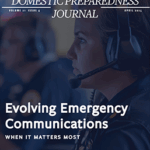In the first week of December 2015, more than 1,000 professionals in healthcare-related organizations, emergency management agencies, public health departments, emergency medical services (EMS), nongovernmental organizations, and academia met in San Diego, California, to discuss ways to bolster partnerships within and between these disparate groups.
In the 10 years since Hurricane Katrina prompted the U.S. Department of Health and Human Services (HHS) to promote the development of healthcare coalitions to enhance regional healthcare readiness for disasters, they have proven their worth in responses to events like the 2013 Boston Marathon bombing and the October 2015 South Carolina floods. However, given the evolving nature of threats, coalitions dedicated to resilience must build relationships beyond their traditional partners, said experts at the fourth annual National Healthcare Coalition Preparedness Conference (NHCPC), held 1-4 December 2015 in San Diego, California.
“We do our organizations a disservice if we only look within our walls because of the unique role that healthcare now more than ever plays in our communities,” said Skip Skivington, vice president of healthcare continuity management and support services for Kaiser Permanente.
Coalitions & Behavioral Health The NHCPC is a program of the National Healthcare Coalition Resource Center, which was founded in 2012 by the MESH Coalition of Indianapolis, the Northern Virginia Hospital Alliance, and the Northwest Healthcare Response Network, which serves the greater Seattle area. “The founders wanted to promote the development of evidence to support this great healthcare coalition movement,” said Virginia Cane, director of Indiana’s Marion County Public Health Department and chair of MESH, which organized this year’s conference with support from an advisory committee of national healthcare preparedness experts.
Many healthcare coalitions started as groups of hospitals working with their local health departments to discuss mutual aid and pool resources from the HHS Hospital Preparedness Program and similar federal initiatives. As a testament to the growing scope of coalitions, the more than 1,000 attendees in San Diego included representatives of emergency management agencies, public health departments, emergency medical services (EMS), nongovernmental organizations, academia, and a wide range of healthcare service providers.
Nicole Lurie, HHS assistant secretary for preparedness and response (ASPR), shared that about half of the nearly 500 healthcare coalitions nationwide feel they are capable of responding to a disaster. ASPR hopes to grow that number with the provision of new tools like emPOWER, an initiative that uses federal health data to map populations with special medical needs to a zip-code level, and the promotion of new partnerships. As an example, Lurie pointed to ASPR’s own evolution since 2009, “When I first came to ASPR, although people recognized that behavioral health consequences of disasters were common, we didn’t really have a plan for how we were going to respond in a behavioral health sense to events. I think what we’ve learned is that every single event has behavioral health consequences.”
Her point was underscored by the tragic mass shooting at a San Bernardino County Department of Public Health holiday party on the second day of the NHCPC conference. Susan Fanelli, assistant director of the California Department of Public Health, told attendees that the breadth of agencies involved in the initial response raised her hopes for post-disaster mental health in San Bernardino. “We’re going to have a lot of issues that are really going to test that community,” she said. “But when I saw them jump into action, it was about the relationships. It’s not just about better integration of public health and medical, it’s about all of that community.”
Public Safety, Long-Term Care & Other Partners In addition to the expanded emphasis on behavioral health, this year’s conference focused on the inclusion of long-term care and U.S. Department of Veterans Affairs facilities in healthcare preparedness planning. Representatives of Voluntary Organizations Active in Disaster and the National Oceanic and Atmospheric Administration spoke to their organizations’ respective abilities to support coalitions with response resources and hazard predictions.
Several anecdotes stressed the growing relationship between public safety and public health in response. Mark Fletcher, deputy chief of EMS for the Baltimore City Fire Department, shared his city’s experience with civil unrest in April 2015 following the controversial death of an arrestee in police custody. Baltimore’s law enforcement officers and first responders became the target of attacks by angry protesters. With its resources overstretched, the Fire Department called on its public health and hospital partners to assist EMS with delivery of care and coordinate the provision of dialysis and medications to those who needed them during several days of curfews and gridlock.
Federal initiatives are also driving integration of healthcare partners. The Centers for Medicare and Medicaid Services’ emergency preparedness rule, which is expected to be finalized in early 2016, will require more comprehensive disaster planning for many types of healthcare facilities. Lurie encouraged coalitions to seize the opportunity to rally these critical partners for collective planning, training, and exercises. She also advised coalitions to leverage the resources of large healthcare systems with geographically distributed supply and personnel networks.
To attract new partners, Jeannette David, disaster mental health coordinator at the Georgia Department of Behavioral Health and Developmental Disabilities, suggested that coalitions make the case for how a few hours of staff time a month can save an organization from closure. According to the Insurance Institute for Business and Home Safety, 25 percent of disaster-affected businesses do not reopen after a major disaster. Scott Cormier, vice president of emergency management, environment of care and safety at Medxcel Facilities Management, encouraged a similar approach for those struggling to make the preparedness case to leadership within an organization. In the aftermath of Hurricane Ike, his previous company, the Hospital Corporation of America, saved $3.5 million by investing in preparedness measures that enabled them to keep 36 patient rooms and four operating rooms open that would otherwise have closed.
“I think resilience and preparedness is a financial equation that most healthcare executives don’t understand. They see it as a line item on a spreadsheet when we have to cut costs,” Cormier said. “If you’re not prepared and you have damage where you can’t accept patients, that’s an even bigger number.”
Healthcare coalitions also have to scrape for funding. Richard Reed, senior vice president, disaster cycle services, for the American Red Cross, advised leaders to look beyond ever-shrinking federal funding for financial sustainability. “I don’t think the government is the answer,” he said. “I think it’s the private sector. I think it’s corporations. I think it’s community organizations that fund people like me every day. Coalitions add value in a way that government can’t.”
The fifth annual NHCPC is slated for 12-15 December 2016 in Alexandria, Virginia. For more information, visit www.healthcarecoalitions.org.

Jessica Wambach Brown
Jessica Wambach Brown, M.A., is a freelance writer with years of experience in healthcare emergency preparedness, including positions at the MESH Coalition, the Northwest Healthcare Response Network, and the Department of Defense’s Center for Excellence in Disaster Management and Humanitarian Assistance. Previously, she was a reporter and editor at newspapers in Washington, Montana, and Virginia. She holds an M.A. in diplomacy and military studies from Hawai’i Pacific University and a B.A. in journalism and history from the University of Montana. She resides in the Seattle, Washington, area.
- Jessica Wambach Brownhttps://www.domesticpreparedness.com/author/jessica-wambach-brown
- Jessica Wambach Brownhttps://www.domesticpreparedness.com/author/jessica-wambach-brown
- Jessica Wambach Brownhttps://www.domesticpreparedness.com/author/jessica-wambach-brown






